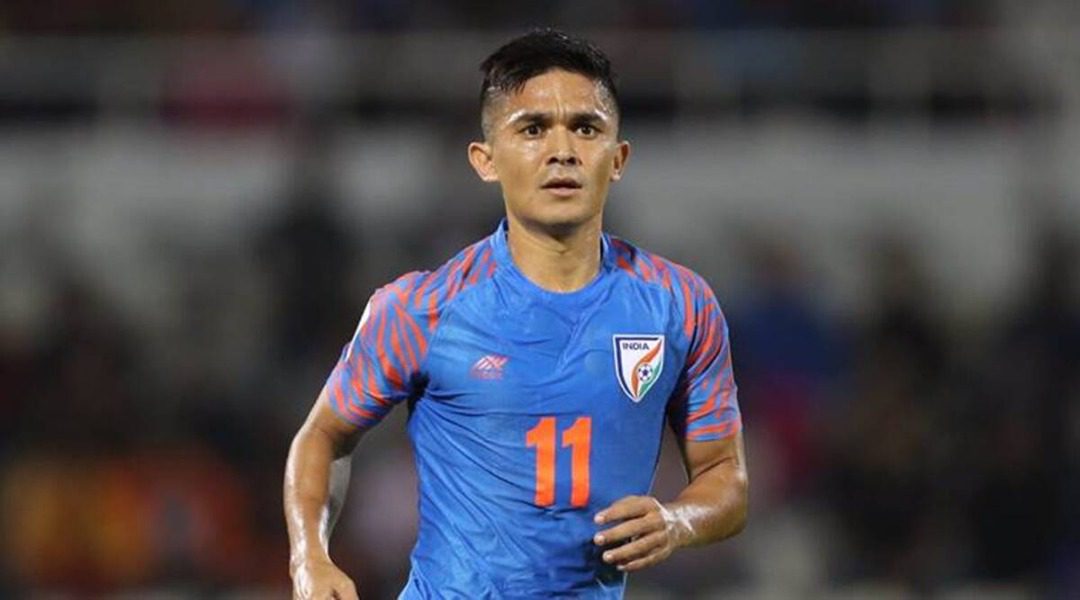(July 15, 2021; 7:15 pm) Sunil Chhetri may not be a name taken in the same breath as Christiano Ronaldo and Lionel Messi but the Indian footballer is nothing short of a shooting star in a cricket-crazy country. The 36-year-old striker has many accolades up his sleeve but this year’s unbelievable feat of surpassing the Argentinian football superstar as the second-highest active international goal-scorer is undeniably an applaud worthy achievement.
Chhetri is one player who has kept the football fever alive in a country like ours. From making stellar contributions in several Nehru Cup wins to weaving his magic at the AFC Cup final, the footballer has risen to the occasion when it mattered the most.
Streets of Delhi to Mohun Bagan
Born a year after India brought home its first cricket World Cup trophy, Chhetri grew up at a time when football was hardly an aspirational sport for Indians. With the likes of Sachin Tendulkar taking on the international cricket in his growing years, the 5 feet seven inches lad was keen to be the next master blaster. But destiny dealt him a different hand.
Raised in a simple middle-class family, Chhetri couldn’t muster up the courage to ask his parents to buy him a bat and pads which could cost a few thousand back in the day. So, he chose football instead. In a conversation with Sportskeeda, he said:
“The moment I realized that the price of the bat and pads was that, the dream was finished there. I didn’t have the guts to tell a guy who used to earn 8000 rupees, my father, to give me 2000 rupees just for my pads and my bat.”
Chhetri went through many hardships before getting his big break. He wouldn’t have shoes sometimes or would stitch his football shoes to continue playing as his father, an army man, couldn’t afford a new pair each time. “We weren’t poor but come 20th of every month, things started looking bit tough. I didn’t have shoes sometimes or didn’t have enough money to go for a trial or didn’t have enough money to take care of my diet.”
Stealing money
Chhetri once revealed that he used to steal money from his mother at times, but one such instance changed his life forever. He straightened up after his mother embraced him teary-eyed and apologized to him for ‘making a thief out of his son.’
“That’s something that shook me. Then I realized that I cannot act like a mischievous kid.”
He had his share of trials before getting the big break at Mohun Bagan in 2002. It was during the Durand Cup that he was playing for City FC from Delhi that he was noticed by Bagan. Seeing the teenager striking some clean goals, Mohun Bagan offered him a three-year contract. He told YouthIncorporatedMagazine,
“I could have never expected it in the wildest of my dreams. Here’s a 17-year-old kid getting signed up by a club as big as Mohun Bagan, that too in the senior team. It felt like a dream.”
International debut at 20
After three years, he earned a call-up to the national team and made his debut in the blue jersey against Pakistan in 2005. Then a 20-year-old Chhetri got his breakthrough at the 65th minute, and since then, there has been no looking back for this football star. It was in the 2007 Nehru Cup that his international career truly kicked off with four goals, and the striker helped India lift the winner’s trophy.
View this post on Instagram
Global Indian footballer
In 2010, Chhetri was signed by Kansas City Wizards of Major League Soccer making him the first Indian to play with the club. This feat gave him the opportunity to play against Manchester United. The 36-year-old came on as a substitute in the 69th minute and showed his world-class game for the rest of the match. His dribble against Paul Scholes was one of the highlights of the match. Though he couldn’t convert any of his strikes to a goal, his team, Kansas City Wizards emerged as the winners.
Nehru Cup star
Back home, Chhetri scored 22 goals in just 33 appearances and helped India win Nehru Cup once again in 2012. A year later, Chhetri became the torchbearer for Bengaluru FC, and as they, the rest is history. Under his captainship, Bengaluru FC spread its wings and went onto win 2 I-Leagues and 2 Federation Cups. Chettri himself scored 49 goals in four seasons, and the club went onto become the first Indian club to reach the AFC Cup final in 2016.
View this post on Instagram
Chhetri helped the club make the transition from I-League to Indian Super League.
He continued to cast his spell in India and was named the AIFF Player of the Year for 2011, 2013, and 2014.
When Chhetri overtook Messi
Over the years, Chhetri has kept the football mania alive in India. But Indian football fans couldn’t keep their calm when in June this year Chhetri surpassed Lionel Messi to become the second-highest active international goal-scorer in the world during FIFA 2022 qualifying match against Bangladesh. Chhetri is truly one of the best football players of recent times.
Editor’s Take
India is known to be a cricket-crazy country with fans glued to ODIs, IPLs, and tests. Amid this mania, Sunil Chhetri has made people sit back and take notice of football. From making India win Nehru Cup thrice to playing against the biggest clubs such as Manchester United or beating Messi to become the second-highest goal-scorer in international football, Chhetri has put his name on the world soccer map. His retirement, whenever that happens, would leave a big hole in Indian football. Chhetri’s story needs to be told more often so that the next generation of Indian footballers can identify with a local role model.
RELATED READ: Samir Banerjee: The mishti-doi loving Indian-American teenager who won the Wimbledon boys singles title

